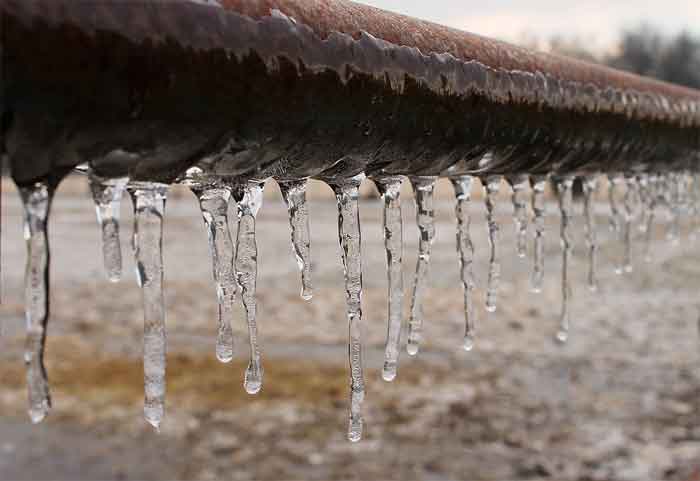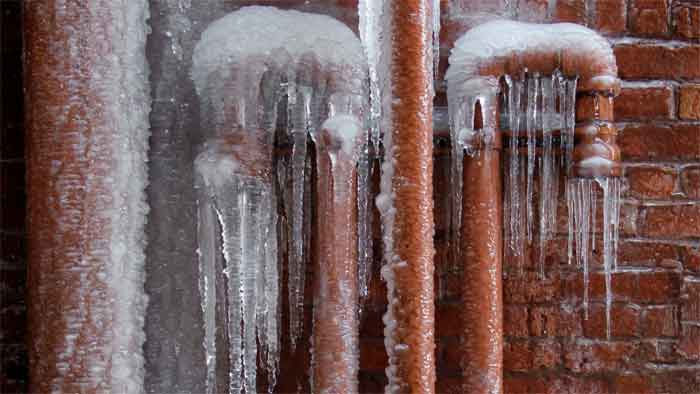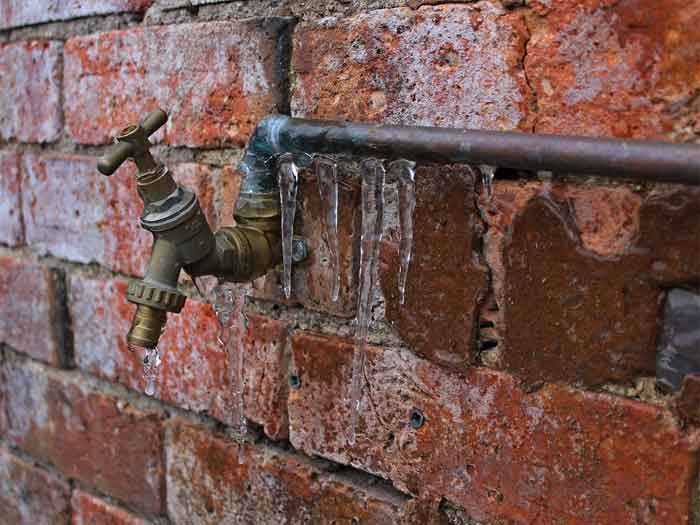Disclaimer: This post may contain affiliate links, meaning we get a small commission if you make a purchase through our links, at no cost to you. For more information, please visit our Disclaimer Page.
As winter and cold weather approaches, there comes a time when each owner needs to prepare plumbing features and pipes in the household. And, therefore, prevent possible costly repairs if the pipes freeze.
While in some countries temperature drops late at the end of the year, in some states colder weather arrives right at the end of the fall, and with it, the air tends to be colder and colder each day.
Eventually, this could lead to extremely cold conditions for water in the household supply line.
The biggest threats for our homes are possible blockages in the main drain system or in the pipes that are not safely secured enough.

At What Temperature do Pipes Freeze?
The most probable cause of water pipes freezing is a low temperature of lesser than 20 degrees Fahrenheit.
At this or lower temperature, pipes that are already damaged are in great danger of rupturing.
This could happen to regular water pipes as well since at this temperature the water tends to freeze and create a blockage in the water flow. This can later lead to either bursting of the pipe and serious flood or blockage of your household's water supply.
The occurrence of these issues may lead to very expensive repairs that could take days, and in all that time you would not be able to use your water.
The freezing water will expand and put you in even more danger depending on how much it expands.
This can, later on, based on the same principle, expand from one pipe to the whole system, making it impossible to use.
In certain cases when the air is cold enough, even cold wind breaking through into the area where pipes are can result in freezing of the pipes.
When a pipe bursts, the costs of the repairs raise significantly, so if not prepared on time, freezing of the pipes can lead to big amounts of money spent on fixing the damage.
For all of the listed reasons, when cold climate arrives, every homeowner should be adequately prepared and protect the water pipes in the household.

How to Prevent Pipe from Freezing - A Checklist
Luckily, there is a whole series of countermeasures you can take to rest assure that your pipes won't freeze in the winter.
The most important advice is to start with the preparation before the cold weather arrives and figure out how much danger your household's pipes are in.
Not all homes have the same insulations of the pipes, while in some cases where the pipes are located underneath the house, or outside, better preparation is needed.
In general conditions, you can take these steps to prevent water from freezing in the pipes:
Insulate Your Pipes
This could be the smartest move when it comes to protecting your pipes from cold. The insulation types offer various specific insulations for every type of pipes, wherever the pipe is located.
For the most effective version of the process, check for the most vulnerable locations of pipes in your household, and purchase insulation designed for higher protection.
This is one of the most affordable options for protection since in case of pipe bursting, you would pay much more on repairs later on.
Let Water Flow
Another affordable and easy solution is to locate the faucets with the pipes which are open to wind or in places like basements or garages.
It is enough to leave at least one of those faucets flowing with low-pressure water, because the moving water in the pipes creates friction and heat, therefore preventing the water to freeze.
Water standing still in the pipes of such open to wind places is in high danger of freezing if the insulation in that room is not efficient enough.
You don’t have to spend way to much water to achieve this, even on very low pressures of flowing, the water in the pipes will move and won’t freeze.
Keep Air Temperature Warm
It might not sound effective, but with constantly warm temperature in your home, the possibility of your pipes freezing will be much less likely to happen.
Be sure to check for all the holes and cracks in the walls for all rooms where the pipes are located, and seal them with at least a tape, to preserve the temperature in the house.
This way, you will be able to withstand the winter without having to apply more serious and expensive insulation.
Let Warm Air Circulate
It often happens that not all rooms in your home get the same heating power.
For that reason, leave the doors open and let air circulate through the main heating point in your home.
You can also turn up the heating in the central heating rooms and ensure that the air in all rooms is warm enough to protect the water in the pipes from cold.
Apply Heating Tapes
Even if you made sure that the pipes inside of your home are safe, there is a chance that the pipes located outside can freeze.
If you have any exterior pipes, use heating tape to make sure that the pipes won’t freeze.
This is one of the most important things you should do since, in case of freezing in external pipes, your inside pipeline can get frozen as well, as previously stated.
The freezing of the water in pipes can spread and eventually lead to freezing of all your pipes.
There are several types of heating tapes, some are more expensive and equipped with sensors for temperature and installed alarm to warn you, but if you are looking for something little bit more affordable you can find quality heating tapes for lower prices.

Steps to Take in Case your Pipes Freeze
Even if you had your pipes warm and secured from the winter, there is always the possibility of spreading the freeze in case one of your pipes get frozen.
In those cases, it is important to know which steps to take to reduce the damage and repairs to a minimum and save yourself from spending a lot of money and nerves by avoiding pipe burst.
First, check for the signs to see how much of the pipes are frozen.
If you see the freeze outside your pipes, try not to warm up the water, and consult with a plumber.
In case that only a small portion of your pipes are frozen, apply these steps to unfreeze your water:
Let Water Flow Through
Try to break the small portion of the pipe entrance and turn up the warm water.
The water flowing will melt the rest of the ice and the whole pipe will unfreeze.
This is possible as long as you can break the ice at the entrance of the pipe since even a small opening will allow water to flow, and break the ice through the pipe.
Apply Heat
If you can find a point where you can physically approach the frozen pipe, apply an electric heater or a hairdryer.
The stronger your heater is, the lesser time will you spend trying to melt the ice.
After successfully melting the ice, turn up the hot water to melt the rest of the frozen pipes.
Insulate the Frozen Pipes with Heat Tapes or Heated Towels
Use any kind of tapes or towel that you can heat and wrap them around the frozen pipes.
The insulation will heat the pipes and slowly melt the ice.
If when trying to heat the pipes you spot a leak, immediately abort any action and hire a plumber to avoid potential floods.

Conclusion: How Cold Does it Have to be For Pipes to Freeze
Getting your pipes frozen can cause a huge mess and take some time to repair in case of blockage.
The temperature limit mentioned before in the article does not necessarily mean that at higher temperatures your pipes will not freeze.
The time needed for the pipes to freeze can be less than a day, and if the wind is cold and constantly blowing, the danger of water in the pipes freezing is bigger.
The article contains crucial information regarding the temperature of the air required for freezing of pipes, as well as the necessary information on how to protect your pipes from freezing, and what to do in case the freezing occurs.
Based on all of the mentioned facts, the most affordable solution for every homeowner is to thoroughly prepare the pipeline for the cold weather and prevent the blockages and pipe bursts from happening.
The cost of possible repairs and installing new pipes and constructions can be much higher than what you would invest in maintaining warmth in your pipeline.

